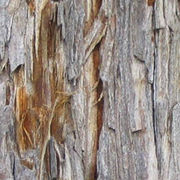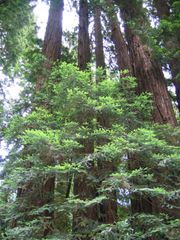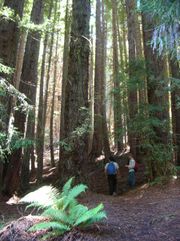Sequoia
2007 Schools Wikipedia Selection. Related subjects: Plants
| iSequoia sempervirens | ||||||||||||||
|---|---|---|---|---|---|---|---|---|---|---|---|---|---|---|
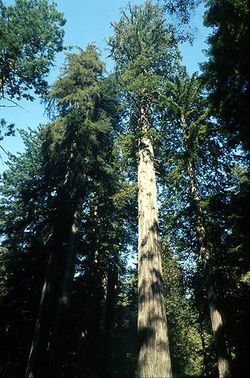 Sequoia sempervirens in Redwood National and State Parks
|
||||||||||||||
|
|
||||||||||||||
| Scientific classification | ||||||||||||||
|
||||||||||||||
|
|
||||||||||||||
| Sequoia sempervirens ( D. Don) Endl. |
Sequoia is a genus in the cypress family Cupressaceae, containing the single living species Sequoia sempervirens. Common names include Coast Redwood and California Redwood (it is one of three species of trees known as redwoods). It is an evergreen, long-lived, monoecious tree living for up to 2,000 years, and is commonly considered the tallest tree in the world, reaching up to 115.5 m (378 ft) in height and 7 m (23 ft) diameter at the base. It is thought to be named after the Cherokee Indian leader, Sequoyah, though this is uncertain.
The name Sequoia is also used as a general term for the subfamily Sequoioideae in which this genus is classified together with Sequoiadendron (Giant Sequoia) and Metasequoia (Dawn Redwood).
The crown is conical, with horizontal to slightly drooping branches. The bark is very thick, up to 30 cm (12 in), and quite soft, fibrous with a bright red-brown when freshly exposed (hence the name 'redwood'), weathering darker. The root system is composed of shallow, wide-spreading lateral roots. The leaves are variable, being 15-25 mm long and flat on young trees and shaded shoots in the lower crown of old trees, and scale-like, 5-10 mm long on shoots in full sun in the upper crown of older trees; there is a full range of transition between the two extremes. They are dark green above, and with two blue-white stomatal bands below. Leaf arrangement is spiral, but the larger shade leaves are twisted at the base to lie in a flat plane for maximum light capture. The seed cones are ovoid, 15-32 mm long, with 15-25 spirally arranged scales; pollination is in late winter with maturation about 8-9 months after. Each cone scale bears 3-7 seeds, each seed 3-4 mm long and 0.5 mm broad, with two wings 1 mm wide. The seeds are released when the cone scales dry out and open at maturity. The pollen cones are oval, 4-6 mm long. The species is monoecious, with pollen and seed cones on the same plant. Its genetic makeup is unusual among conifers, being a hexaploid (6n) and likely autoallopolyploid (AAAABB). The mitochondrial genome is (unlike other conifers) paternally inherited (Neale et al. 1989).
Range and ecology
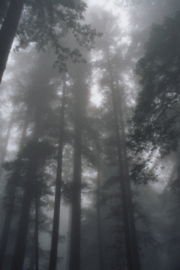
Coast Redwoods occupy a narrow strip of land approximately 750 km (470 miles) in length and 8-75 km (5-47 miles) in width along the Pacific coast; the elevation range is mostly from 30-750 m, occasionally down to sea level and up to 920 m (Farjon 2005). They usually grow in the mountains where there is more precipitation from the incoming moisture off the ocean. The tallest and oldest trees are found in deep valleys and gullies, where year-round streams can flow, and fog drip is regular. The trees above the fog layer, above about 700 m, are shorter and smaller due to the drier, windier, and colder conditions. In addition, tanoak, pine and Douglas-fir often crowd out redwoods at these elevations. Few redwoods also grow close to the ocean due to intense salt spray, sand and wind.
The northern boundary of its range is marked by two groves on the Chetco River on the western fringe of the Klamath Mountains, 25 km (15 miles) north of the California-Oregon border. The largest populations are in Jedediah Smith Redwoods State Park ( Del Norte County), Redwood National Park and Humboldt Redwoods State Park ( Humboldt County). The furthest inland are 75 km from the sea, in Napa County. The southern boundary of the range is marked by a grove in Salmon Creek Canyon in the Santa Lucia Mountains of southern Monterey County.
This native area provides a unique environment with heavy seasonal rains (2500 mm or 100 in annually), cool coastal air and fog keeping this forest constantly damp year round. As this heavy rain has left the soil with few nutrients, these trees depend on the entire biotic community of the forest, and complete recycling of the trees when dead. Logging interrupts this process. This forest community includes Douglas-fir, Western Hemlock, Tanoak, Madrone, and other trees along with a wide variety of ferns, Redwood sorrel, mosses and mushrooms. Redwood forests provide habitat for a variety of mammals, birds, reptiles, and amphibians. Remnant old growth redwood stands provide habitat for the federally threatened Spotted Owl and the California-endangered Marbled Murrelet.
The thick, tannin-rich bark, combined with foliage that starts high above the ground provides good protection from both fire and insect damage, contributing to the Coast Redwood's longevity. The oldest known Coast Redwood is about 2200 years old; many others in the wild exceed 600 years.
The prehistoric fossil range of the genus is considerably greater, with a subcosmopolitan distribution including Europe and Asia until about 5 million years ago.
Statistics
Trees over 60 m (200 feet) are common, and many are over 90 m (300 feet).
- The current tallest tree is Hyperion, measuring at 115.55 m (379.1 feet). The tree was discovered in Redwood National Park during Summer 2006 by Chris Atkins and Michael Taylor and has been measured as the world's tallest living thing. The previous record holder was the Stratosphere Giant in the Humboldt Redwoods State Park, at 112.83 m, last measured in 2004 (was 112.34 m in Aug 2000 and 112.56 m in 2002). Until it fell in March 1991, the "Dyerville Giant" was the record holder. It too stood in Humboldt Redwoods State Park; it was 113.4 metres high and estimated to be 1600 years old.
- There are 15 known living trees more than 110 m (361 feet) tall.
- There are 47 trees that are more than 105 m (344.5 feet) tall.
- A tree claimed to be 115.8 m (380 feet) was cut down in 1912.
- The tallest non-redwood tree is a 100.3 m (329 foot) tall Douglas-fir.
In 2004, an article in Nature reported that the theoretical maximum potential height of Coast Redwoods (or any other tree) is limited to between 122-130 m (400-425 feet), due to gravity and the friction between water and the vessels through which it flows.
The largest in volume is the "Del Norte Titan", with an estimated volume of 1044.7 m³; it is 93.57 m tall with a diameter of 7.22 m. Among current living trees only 15 Giant Sequoias are larger than this; these are shorter, but have thicker trunks, giving the largest Giant Sequoia, General Sherman, a volume of 1,487 cubic metres (52,510 cubic feet). A redwood cut down in 1926 had a claimed volume of 1,794 cubic metres (63,350 cubic feet), but this is not verified.
Reproduction
Coast Redwood reproduces both sexually and asexually. Seed production begins at 10-15 years of age, and large seed crops occur frequently, but viability of the seed is low, typically below 20%. The low viability may be an adaptation to discourage seed predators, which do not want to waste time sorting chaff (empty seeds) from edible seeds. The winged seeds are small and light, weighing 3.3-5 mg (200-300 seeds/g; 5600-8500/ounce). The wings are not effective for wide dispersal, and seeds are dispersed by wind an average of only 60-120 m (200-400 feet) from the parent tree.
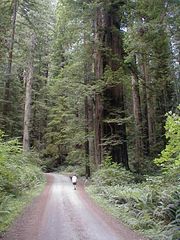
Growth of seedlings is very fast, with young trees known to reach 20 m tall in 20 years. Coast Redwoods can also reproduce asexually by layering or sprouting from the root crown, stump, or even fallen branches; if a tree falls over, it will regenerate a row of new trees along the trunk. This is the reason for many trees naturally growing in a straight line. Sprouts originate from dormant or adventitious buds at or under the surface of the bark. The dormant sprouts are stimulated when the main adult stem gets damaged or starts to die. Many sprouts spontaneously erupt and develop around the circumference of the tree trunk. Within a short period after sprouting, each sprout will develop its own root system, with the dominant sprouts forming a ring of trees around the parent root crown or stump. This ring of trees is called a "fairy ring". Sprouts can achieve heights of 2.3 m (8 feet) in a single growing season.
Redwoods may also reproduce using burls. A burl is a woody lignotuber that commonly appears on a redwood tree below the soil line, though when above, usually within 3m of the soil. Burls are capable of sprouting into new trees when detached from the parent tree, though exactly how this happens is yet to be studied. Shoot clones commonly sprout from burls and are often turned into decorative hedges when found in suburbia.
The species is very tolerant of flooding and flood deposits, the roots rapidly growing into thick silt deposits after floods.
Cultivation and uses
Coast Redwood is one of the most valuable timber species in California, with 364,000 ha of redwood forest, all second growth, managed for timber production . Coast Redwood lumber is highly valued for its beauty, light weight, and resistance to decay. It is also resistant to fire since it does not burn well due to its lack of resin.
P. H. Shaughnessy, Chief Engineer of the San Francisco Fire Department wrote:
- In the recent great fire of San Francisco, that began April 18th, 1906, we succeeded in finally stopping it in nearly all directions where the unburned buildings were almost entirely of frame construction and if the exterior finish of these buildings had not been of redwood lumber, I am satisfied that the area of the burned district would have been greatly extended.
Redwood burls are used in the production of table tops, veneers, and turned goods. The phenolics and tannins present in old growth redwood stock affords excellent termite and water damage protection. Old growth redwood construction is highly prized as a result. Only 3 percent of the present redwood forest is old growth, but not all of it is protected from further exploitation. The Pacific Lumber Company, a subsidiary of the Maxxam Corporation, continues to log old growth Redwoods despite decades of public protest. More and more of the second growth forest is being converted into protected areas with hopes of them taking on old growth forest characteristics. Examples of this are the Big Basin State Park and the recently acquired San Lorenzo River Redwoods. Some of the remaining forest consists of redwood plantations grown on a short (40-70 years) rotation. Other areas are slowly succumbing to suburban sprawl.
The Coast Redwood is locally naturalized in New Zealand, notably at Rotorua. Other areas of successful cultivation outside of the native range include western Europe from the British Isles south to Portugal, the Queen Charlotte Islands, middle elevations of Hawaii, and the southeastern United States from eastern Texas to North Carolina.

